25 Types of Shrubs to Consider for Your Landscape
Branch out from your typical trees and flowers


Whether you’re looking for lush florals and greenery to accent your landscape or bushy background plants for your flower garden, shrubs are a perfect addition. With fragrant blossoms and brilliant foliage spanning a full spectrum of colors, there are different types of shrubs to suit any landscape. Consider these 25 popular shrubs for your next landscaping project.
1. Lilac
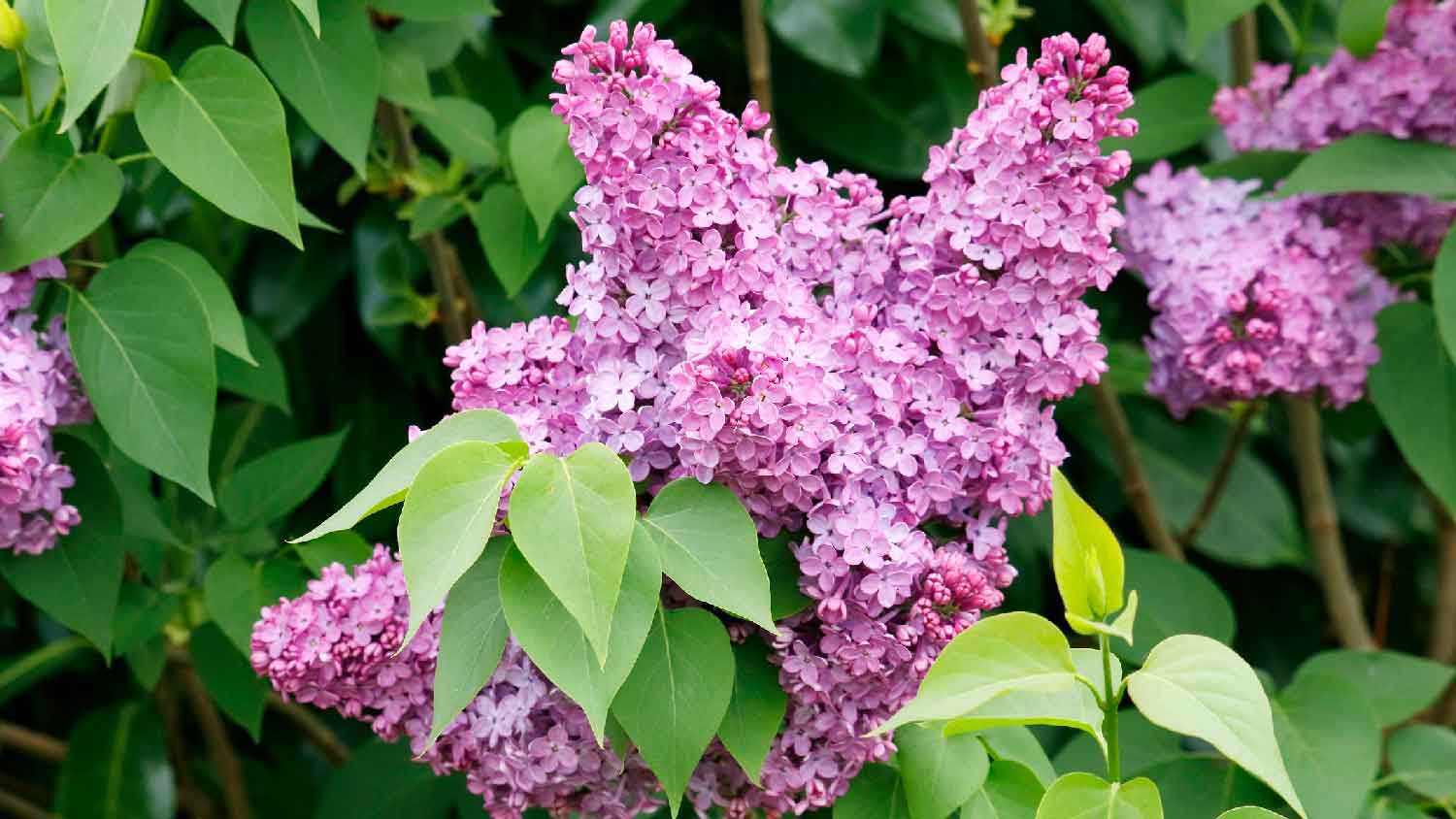
Sunlight Requirements: Full sun
Care: Prune immediately after the last blossoms are spent
USDA Hardiness Zones: 3–7
Lilac bushes are a quintessential spring-flowering shrub. Its large flower clusters blossom once a year, filling the surrounding landscape with sweet fragrance and showstopping color.
2. Yew

Sunlight Requirements: Prefers full sun; tolerates partial sun to full shade
Care: Prune occasionally to maintain shape and remove floppy branches
USDA Hardiness Zones: 4–7
Yews are evergreen shrubs that are known for their dense, dark green foliage and red, berry-like cones. Often used for hedges, these dense shrubs are relatively low maintenance and can even grow in full shade. However, every part of the plant is toxic except for the fruit, so it’s not suitable for properties with small children or curious pets.
3. Juniper
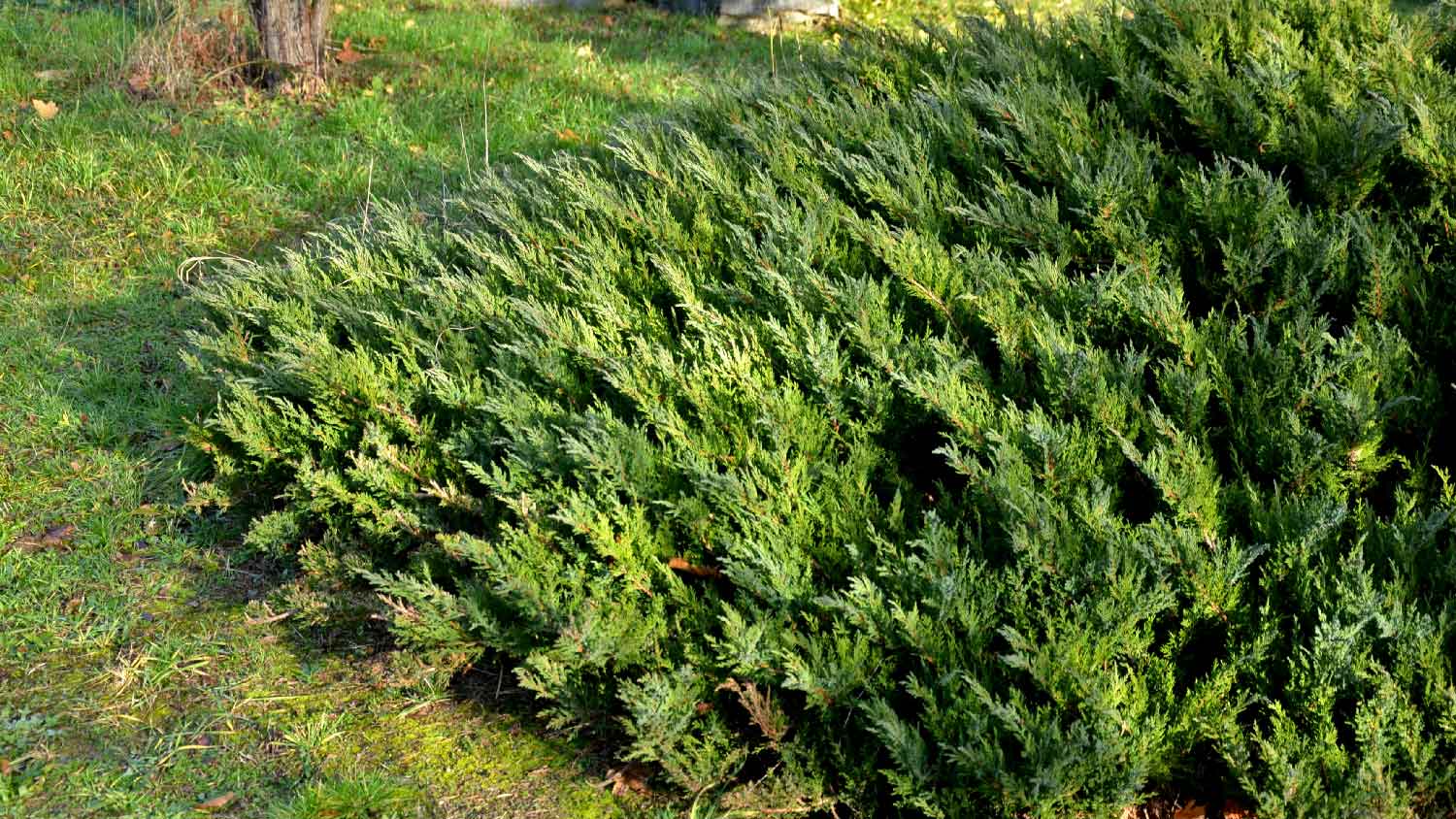
Sunlight Requirements: Prefers full sun
Care: Prune for shaping if necessary
USDA Hardiness Zones: 3–9
Juniper is a species of coniferous shrub with needle-like foliage ranging in color from gold to blue to silvery green. It has a strong herbal fragrance (like gin) and produces blue or green berries. Available in various sizes and shapes, juniper shrubs are hardy and low maintenance once established.
4. Arborvitae
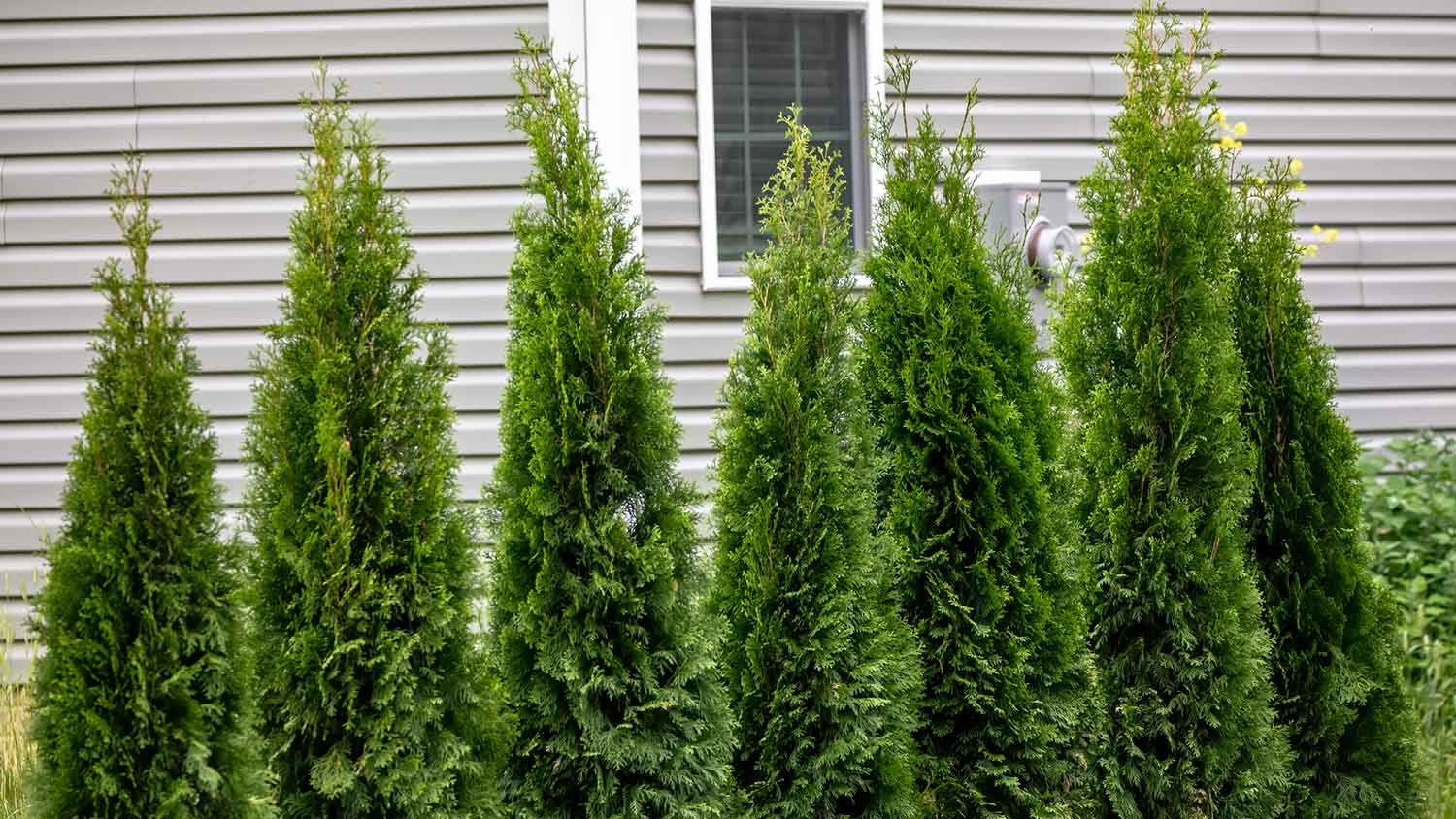
Sunlight Requirements: Full sun to partial shade
Care: Prune as needed to maintain shape; regular watering in the first year is crucial for proper establishment
USDA Hardiness Zones: 2–7
Arborvitaes are tall, narrow evergreen shrubs with scale-like leaves that are arranged in flattened sprays. These tall, dense bushes are low maintenance and popular for privacy screens when neighboring yards are in close quarters.
5. Burning Bush
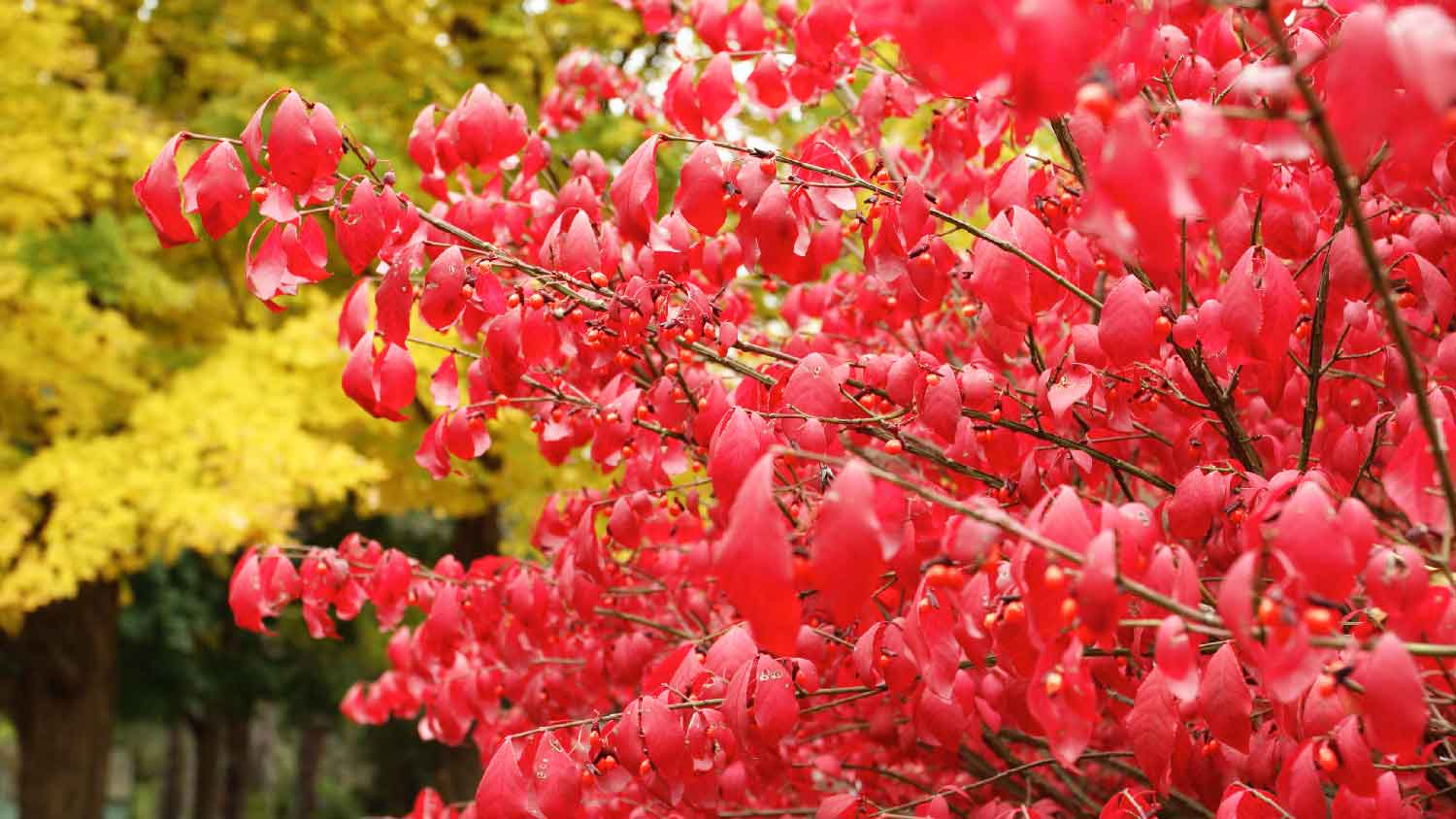
Sunlight Requirements: Full sun to partial shade
Care: Prune suckers and immediately harvest fall berries to prevent overspreading
USDA Hardiness Zones: 4–8
Burning bushes are deciduous shrubs with vibrant red foliage in autumn, adding striking color to landscapes. These brilliant bushes are low maintenance—almost to a fault—as they can grow and spread quickly if suckers aren’t pruned regularly. Although popular, burning bushes are considered invasive, and an increasing number of municipalities are banning them. If you love the look of a burning bush but can’t find one to purchase, a local landscaping company can suggest some good alternatives.
6. Hydrangea
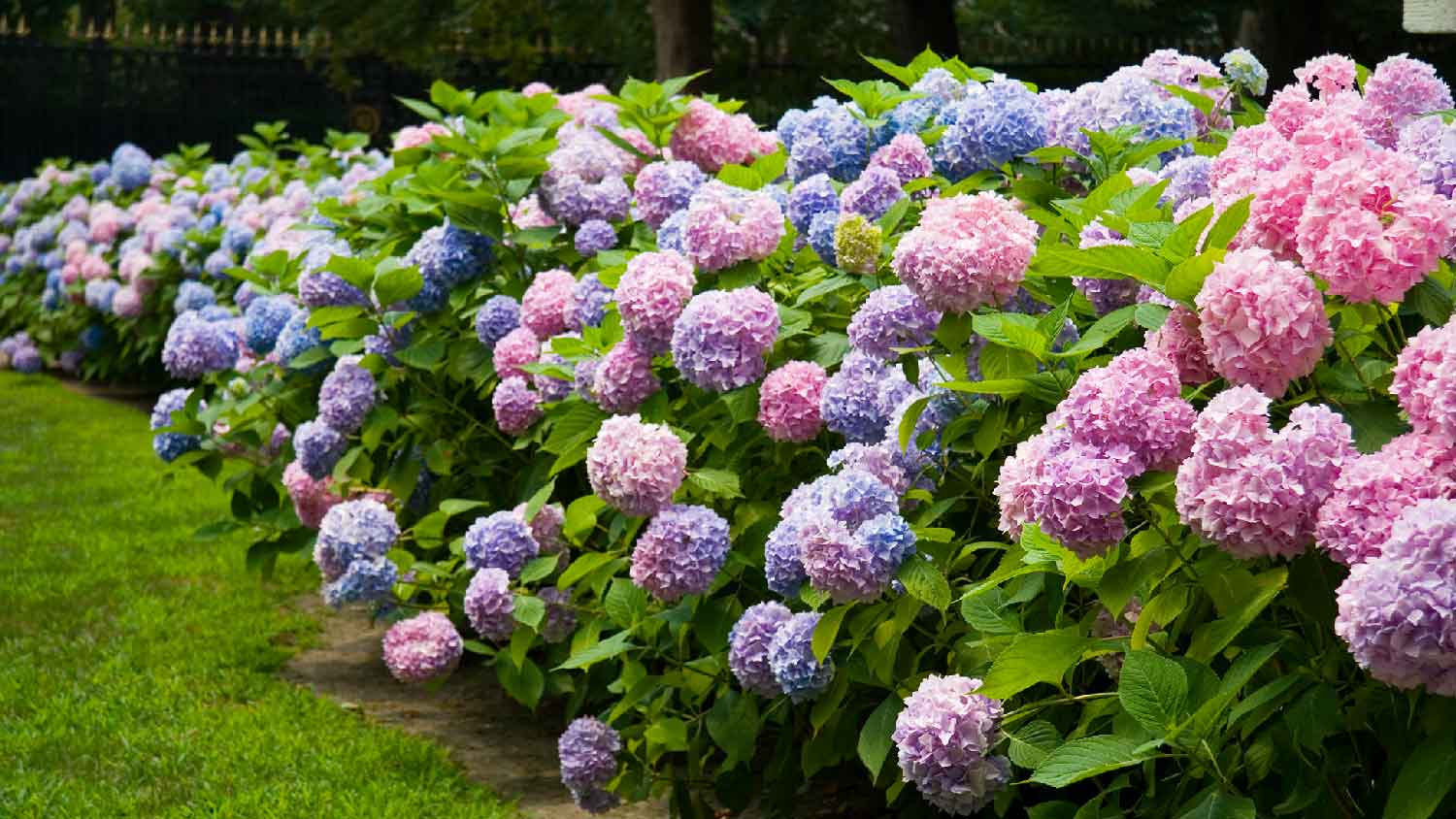
Sunlight Requirements: Partial shade
Care: Keep soil moist
USDA Hardiness Zones: 3–9 (depending on variety)
Hydrangeas are flowering shrubs with large, showy clusters of blooms in various hues of white, pink, blue, or purple. They are known for their versatility and ability to change bloom color based on soil conditions: Acidic soil yields blue flowers, while neutral or basic soil yields red or pink flowers.
7. Rose

Sunlight Requirements: Full sun
Care: Full pruning once per year; pruning to remove spent blossoms and diseased portions as needed
USDA Hardiness Zones: 2–11 (depending on variety)
Another quintessential option for a flowering shrub, it’s hard not to love the beauty and classic romance of a rose bush. These versatile flowering shrubs come in a wide array of colors, sizes, and fragrances. Learning when and how to prune roses based on the type you plant is crucial for getting the most blossoms possible.
8. Boxwood
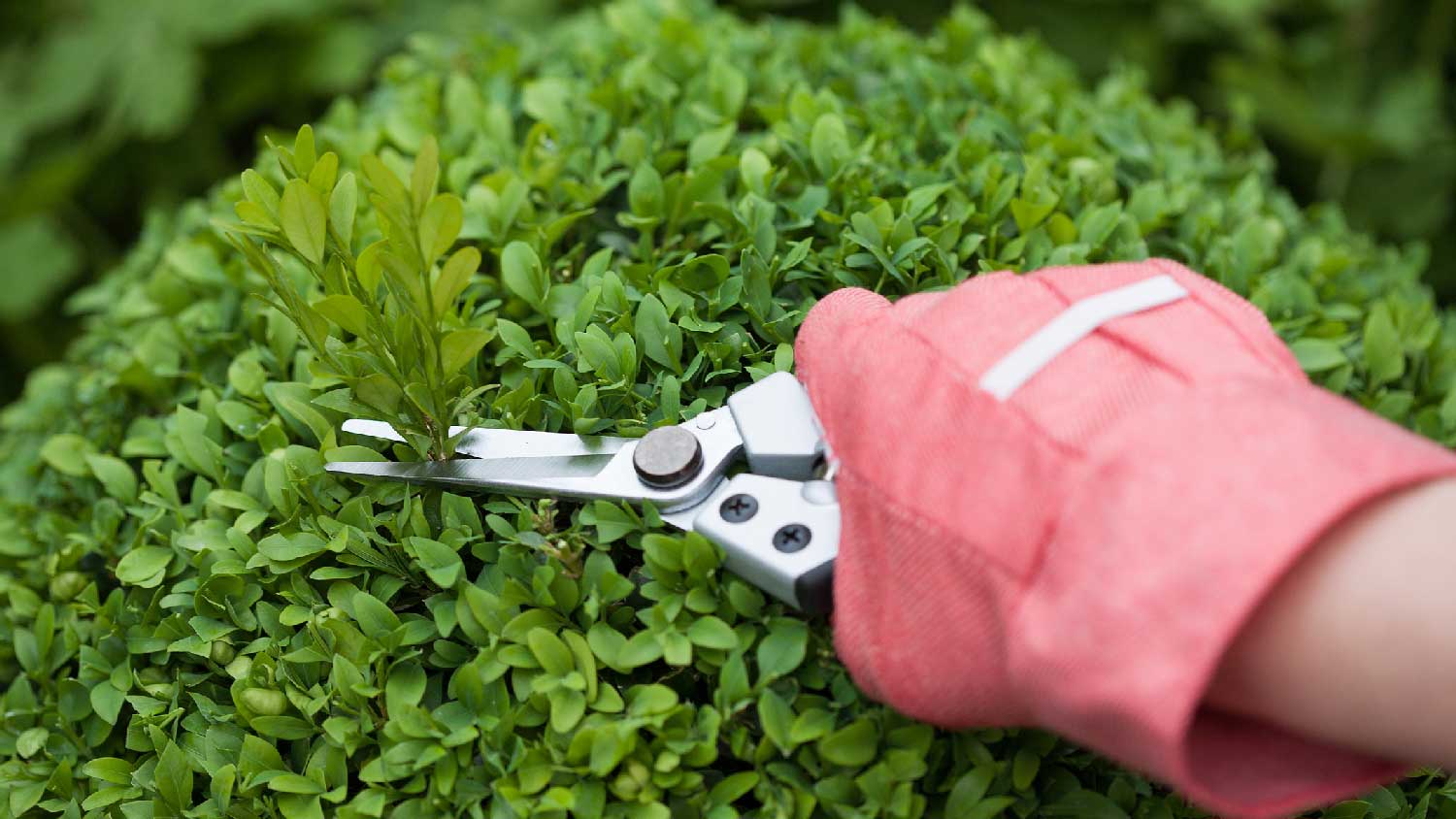
Sunlight Requirements: Full sun to partial shade
Care: Requires consistent watering during the first year of planting; prune to thin and shape as needed
USDA Hardiness Zones: 4–9
Boxwoods are small-leaved evergreen shrubs with versatile style and brilliant green color. Their thick, dense foliage lends itself well to being cut into shapes, so they are often used for formal hedges or topiaries.
9. Camellia
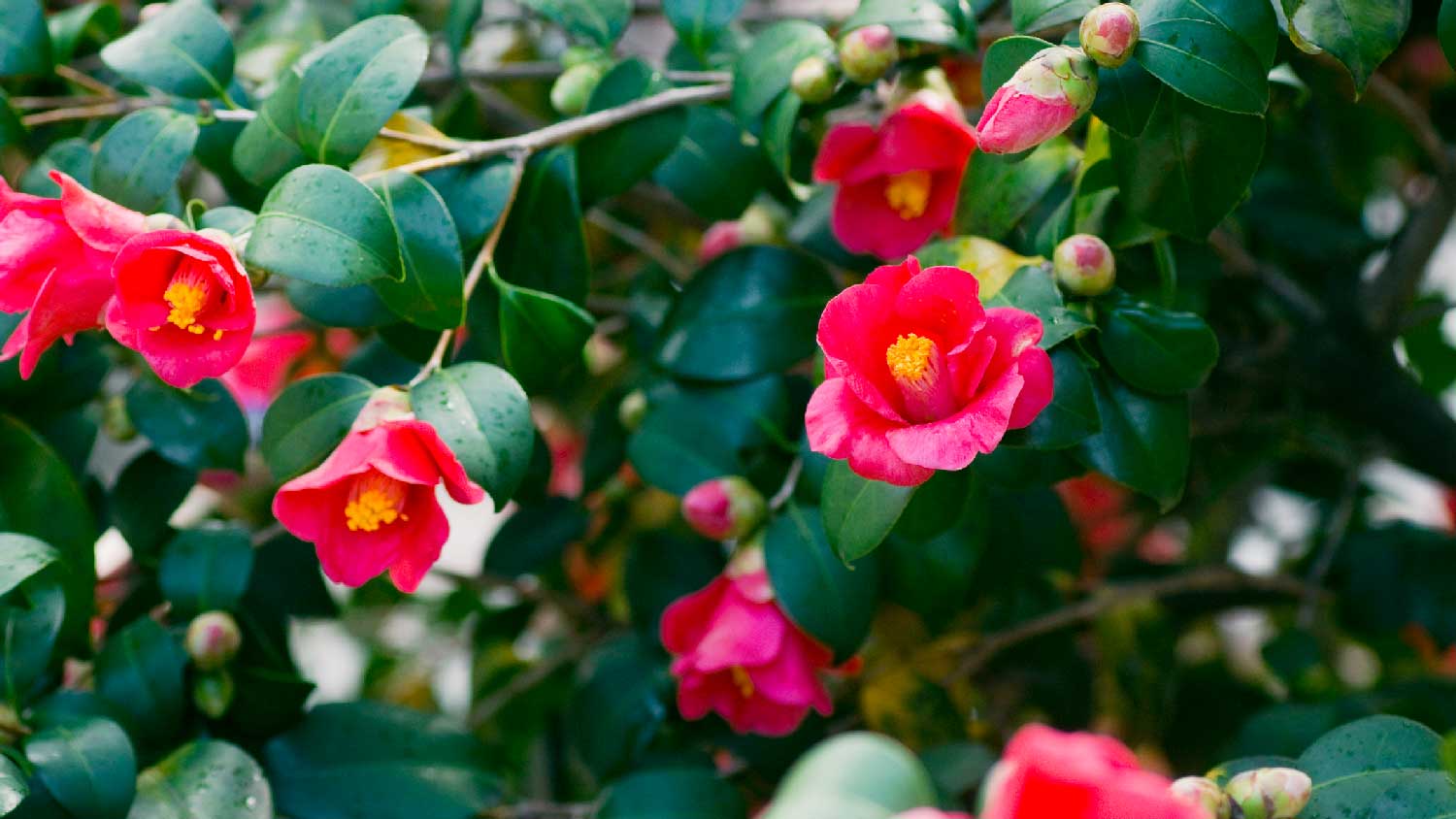
Sunlight Requirements: Partial shade
Care: Prune to remove dead branches as needed
USDA Hardiness Zones: 6–9
Camelias are elegant evergreen shrubs with glossy leaves and large, waxy flowers in shades of pink, red, yellow, lavender, or white. Beloved for their early spring blooms, the showy many-petaled blossoms are often compared to peonies.
10. Distylium
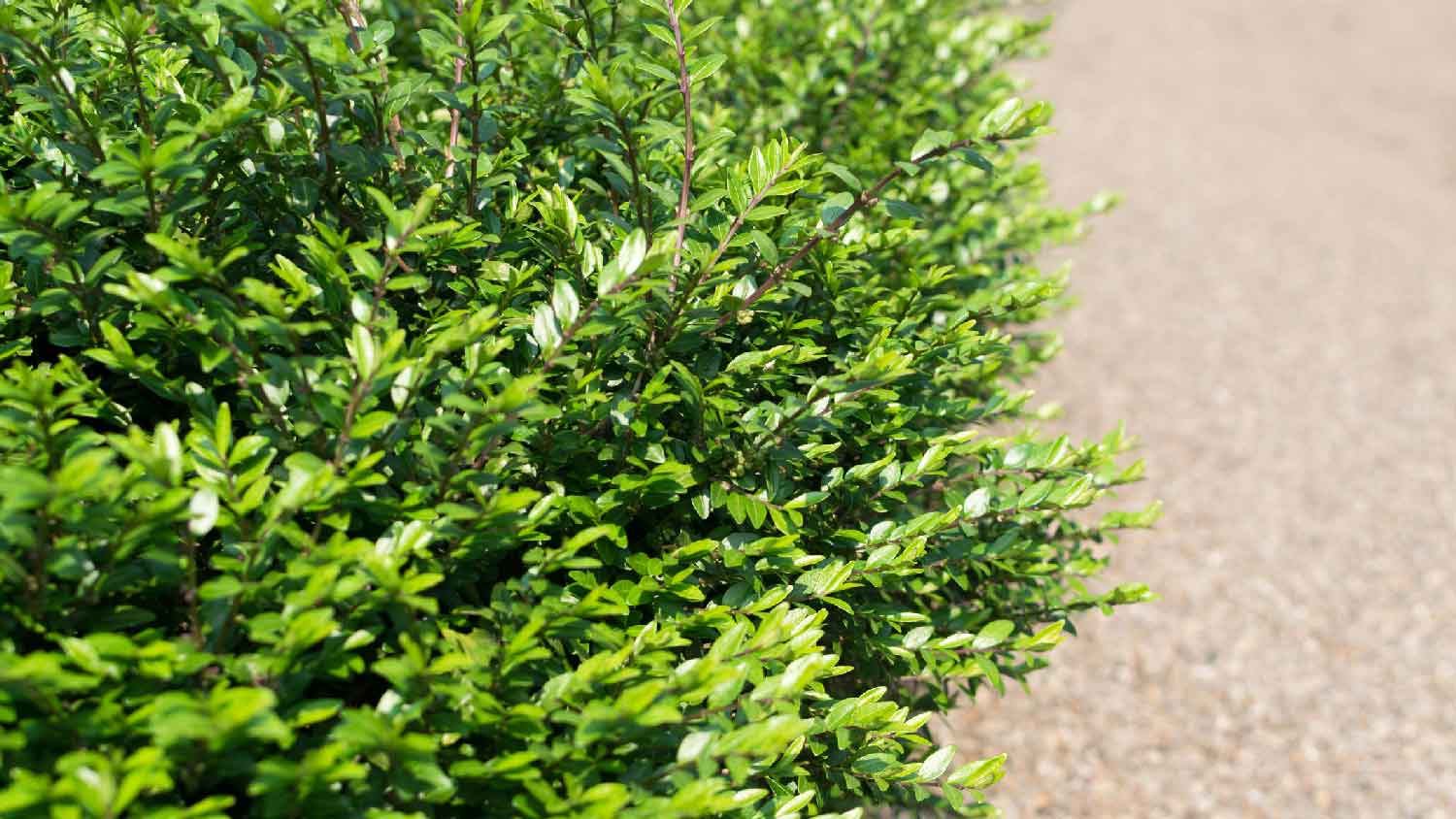
Sunlight Requirements: Full sun to partial shade
Care: Extremely hardy and low maintenance
USDA Hardiness Zones: 7–9
Distyliums are compact and low maintenance evergreen shrubs with small maroon flowers that bloom from late January to March. They are prized for their hardiness, drought tolerance, and resistance to disease and insects.
11. Spirea
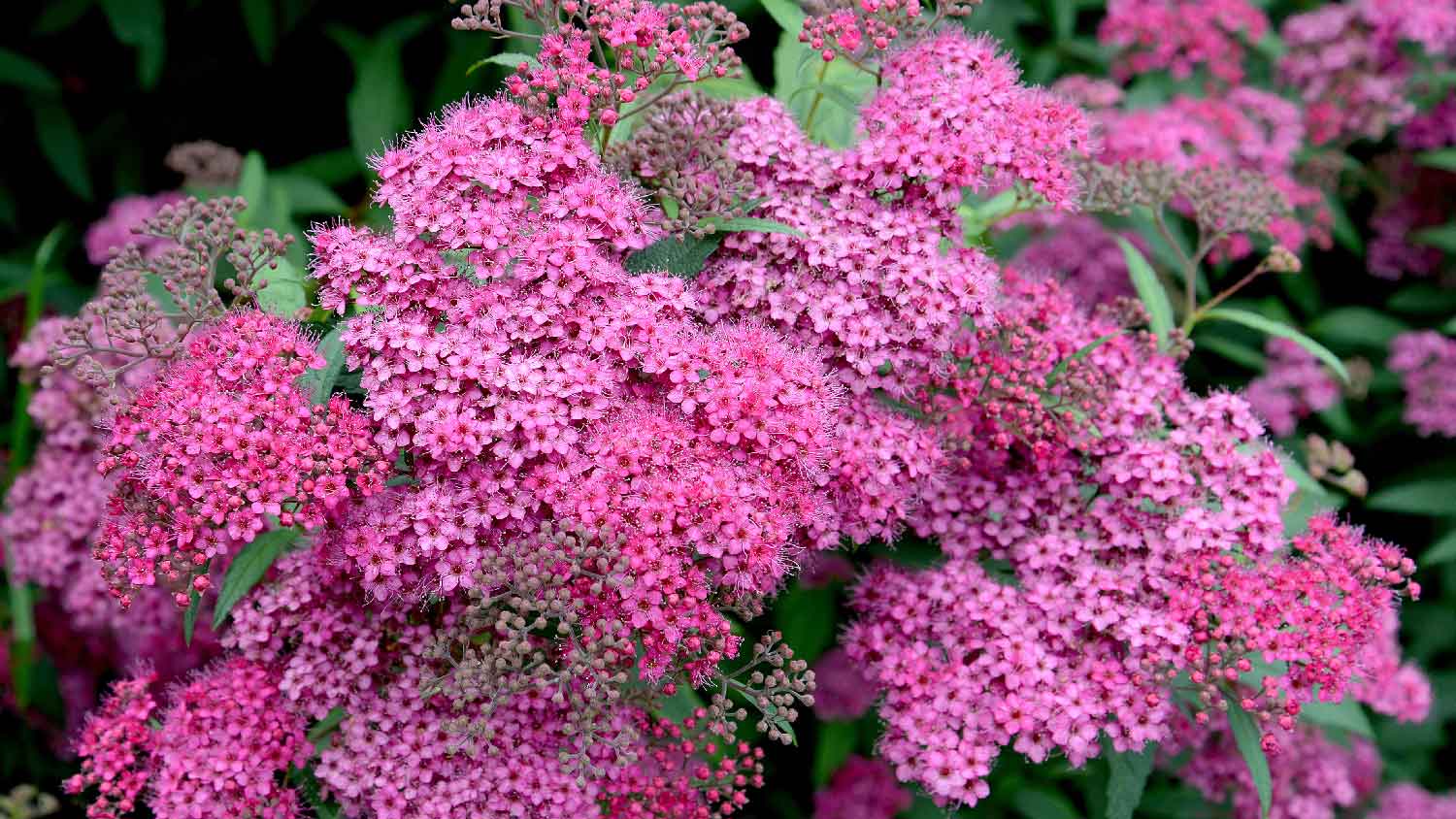
Sunlight Requirements: Full sun
Care: Pruning after flowering can encourage reblooming
USDA Hardiness Zones: 3–8 (depending on variety)
Spireas are deciduous shrubs with clusters of delicate, cascading flowers in white, pink, or red. These shrubs are known for their graceful arching branches and beautiful clusters of blossoms. Spirea is wildly popular with gardeners but is also considered invasive; as a result, you can now find several types of sterile spirea cultivars that won’t spread.
12. Holly

Sunlight Requirements: Full sun to partial shade
Care: Regular watering during dry spells, especially for young plants, helps establish them; pruning to shape and remove dead branches can be done in late winter or early spring
USDA Hardiness Zones: 5–9 (depending on variety)
Holly is an evergreen shrub with spiny, glossy leaves and bright red berries. While they’re often associated with festive decorations for the holidays, holly bushes bring year-round interest with their striking foliage and ornamental berries.
13. Weigela
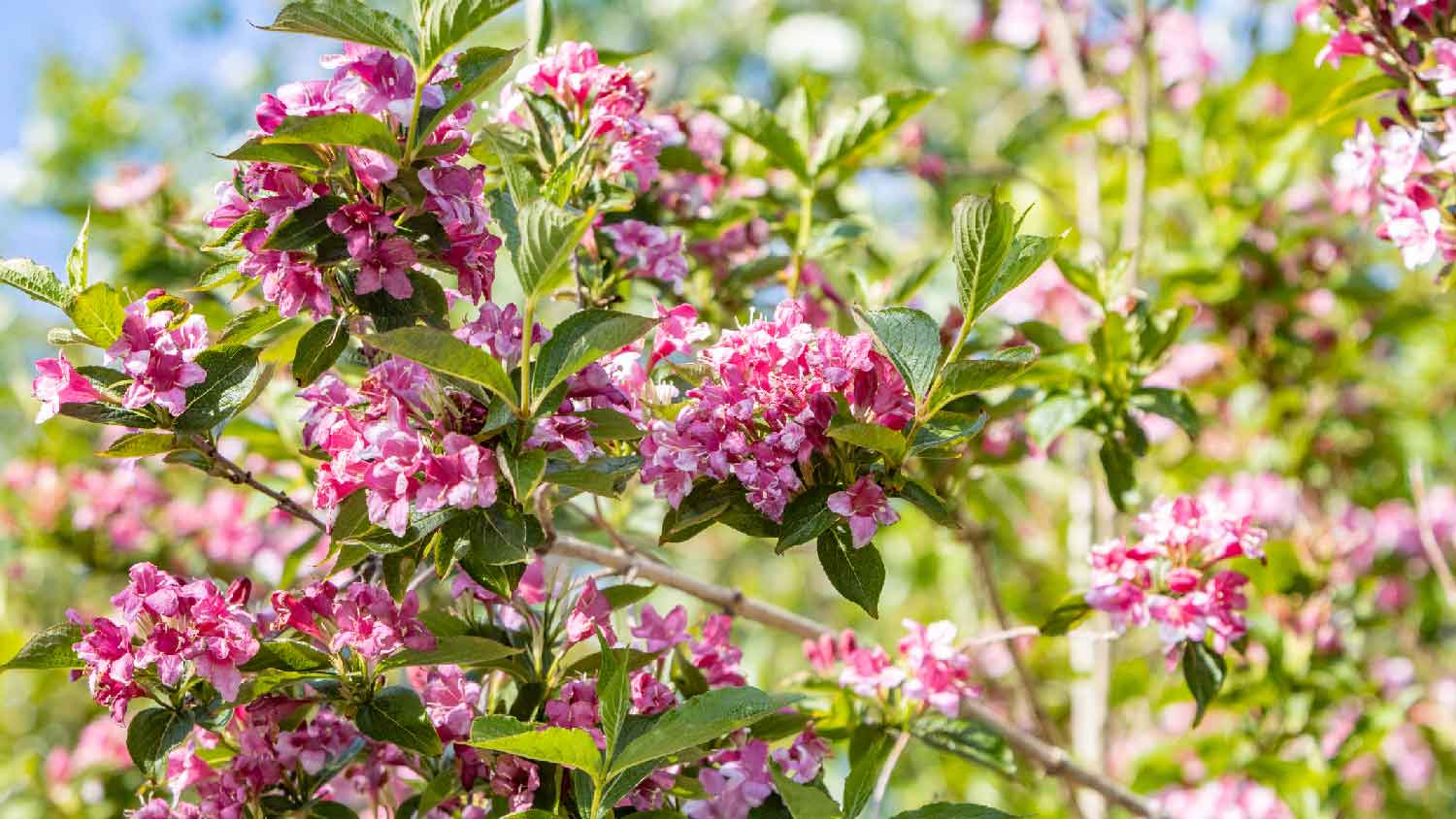
Sunlight Requirements: Full sun to partial shade
Care: Prune after flowering to maintain shape and promote new growth; regular watering is crucial during dry periods, especially for young plants
USDA Hardiness Zones: 4–8
Weigelas are flowering shrubs with trumpet-shaped blossoms in shades of pink, red, or white. Admired for their prolific blooms, these shrubs add a vibrant burst of color to garden landscapes.
14. Purple Leaf Sand Cherry
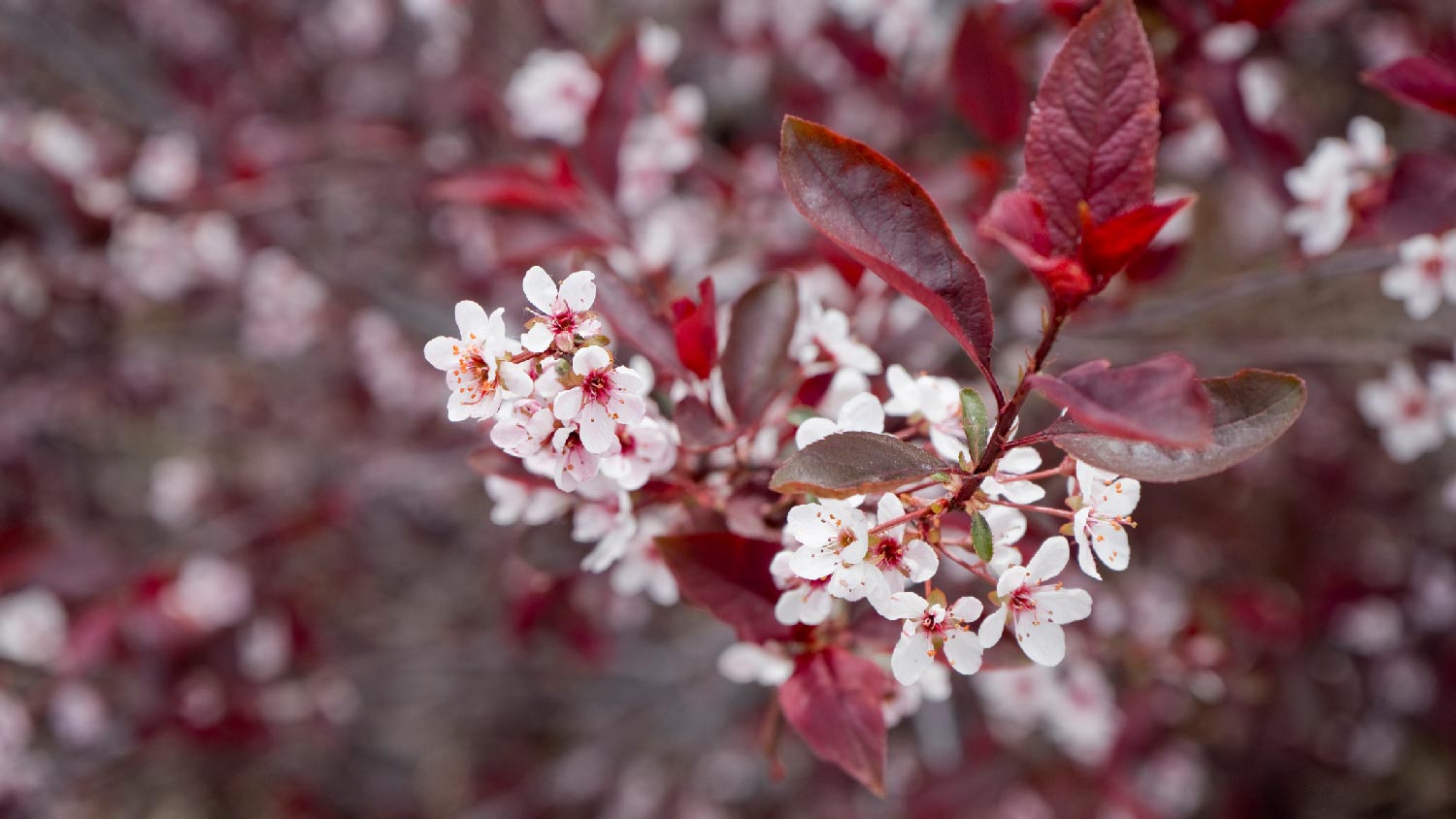
Sunlight Requirements: Full sun
Care: Regular watering, especially in the first year, helps establish young plants; pruning in late winter encourages fruiting and maintains shape
USDA Hardiness Zones: 2–8
Purple sand cherries are deciduous shrubs known for their dark purple foliage and small, fragrant white flowers, followed by edible cherries. The contrast of deep hues and delicate florals makes these shrubs a true showstopper.
15. Dogwood
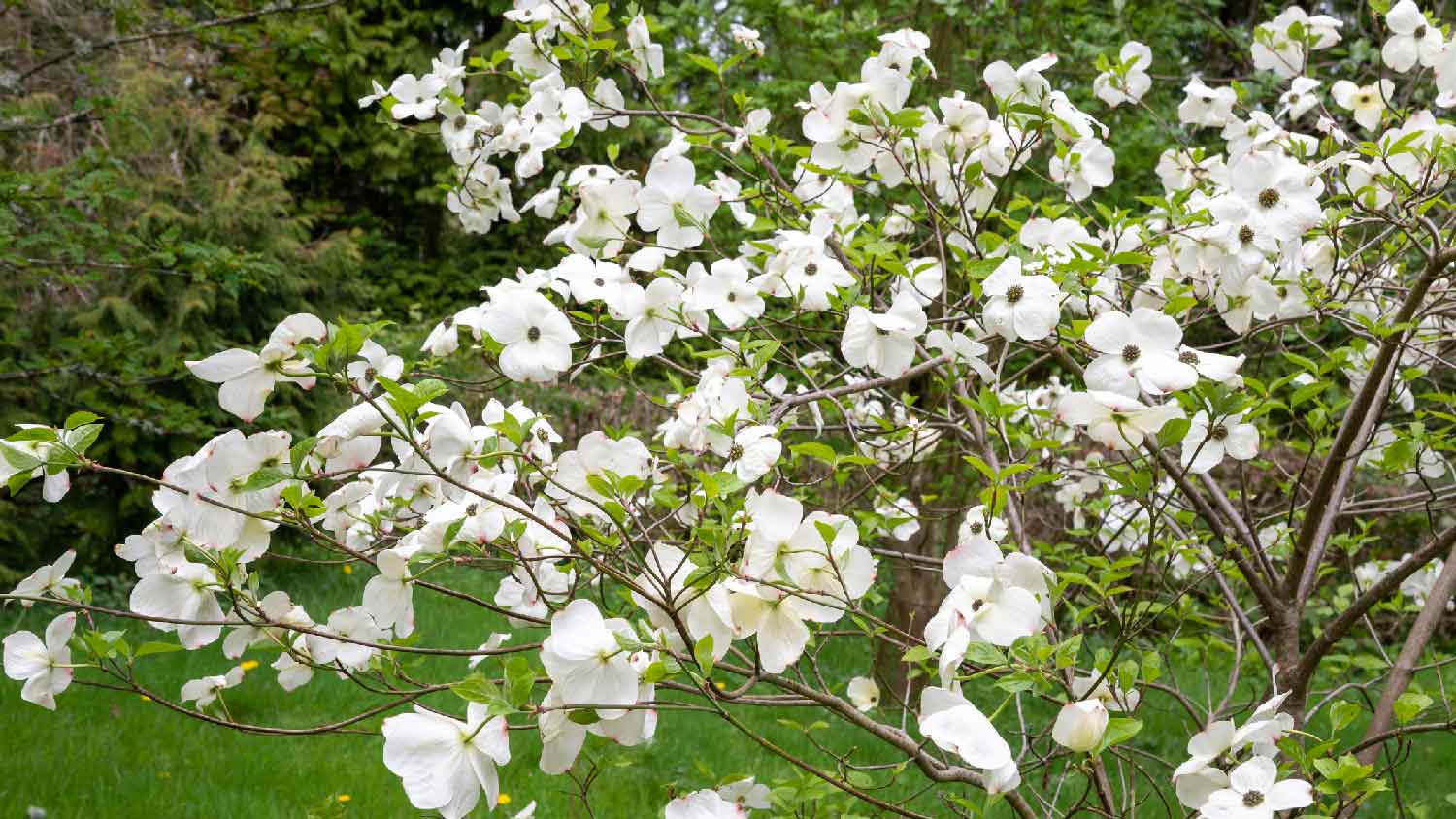
Sunlight Requirements: Full sun to partial shade
Care: Pruning dead, damaged, and faded stems in early spring will promote more colorful stem growth
USDA Hardiness Zones: 2–8
While typically recognized as small trees, certain varieties of dogwoods can be cultivated in shrub form. These beautiful shrubs boast distinctive flowers and vibrant stems that add a splash of color to landscapes.
16. Ninebark
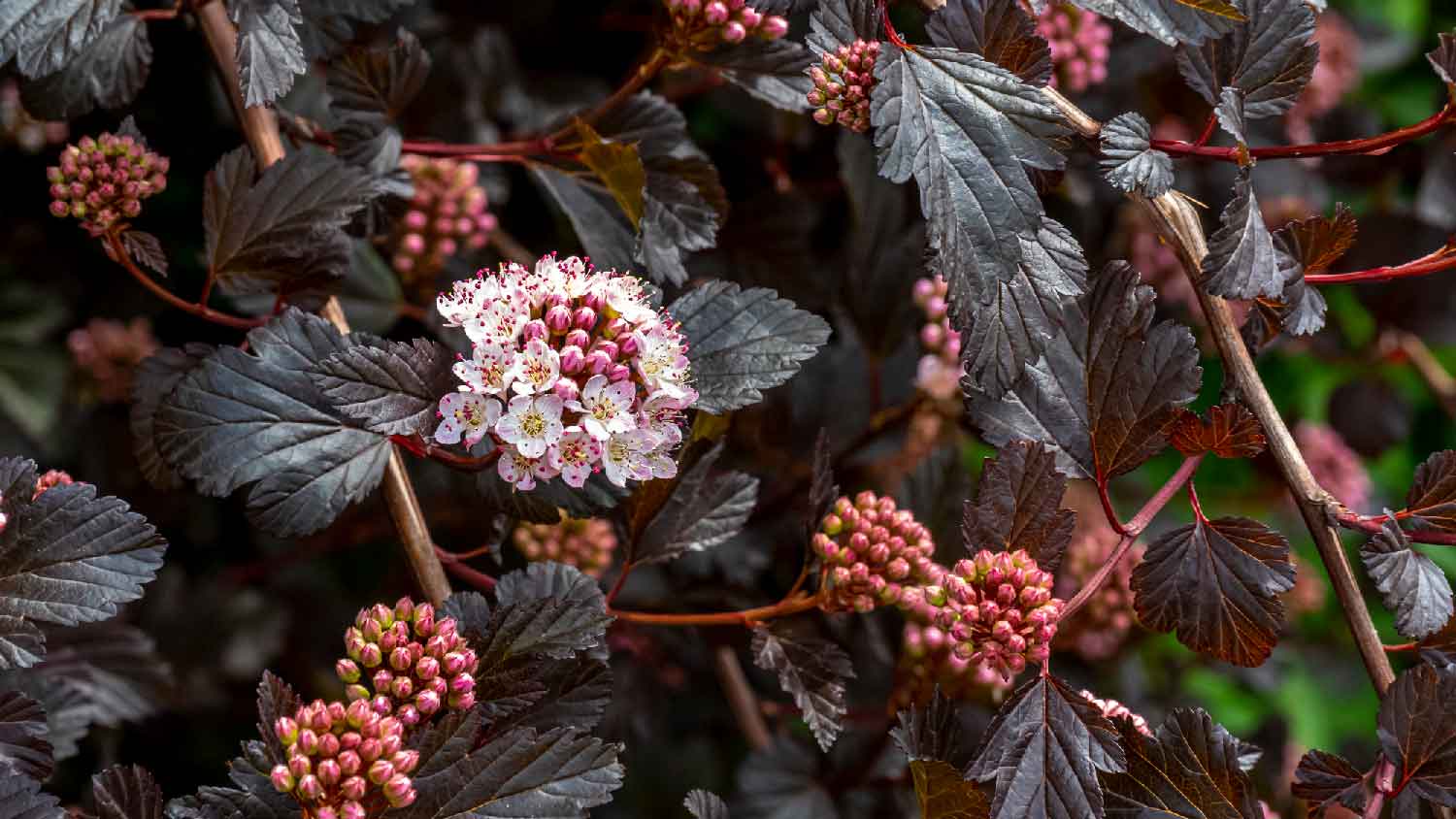
Sunlight Requirements: Full sun to partial shade
Care: Regular watering during dry spells, especially for young plants, helps establish them; pruning in late winter or early spring encourages new growth
USDA Hardiness Zones: 2–8
Ninebark, a hardy deciduous shrub, earns its name from its distinctive peeling bark, adding textural interest to gardens and landscapes. These adaptable shrubs feature clusters of small white or pink flowers that complement their peeling bark.
17. Forsythia
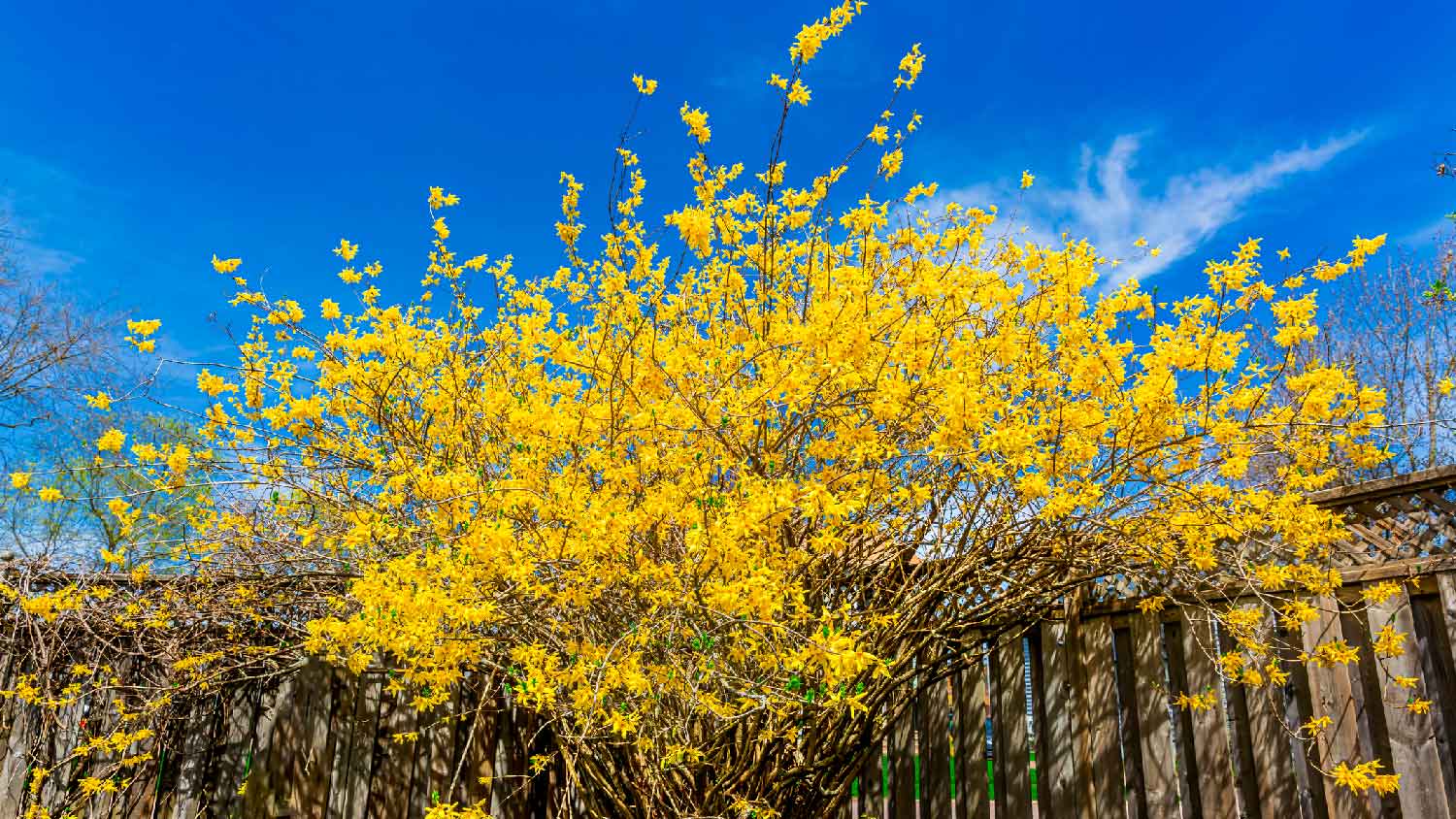
Sunlight Requirements: Full sun
Care: Water regularly and prune after flowering to maintain shape and encourage growth
USDA Hardiness Zones: 5–8
Forsythias, known for their early-blooming nature, burst into life with a bright yellow display of flowers. Among the first blooms of the season, the bright golden blossoms bring a cheery sign that spring has arrived.
18. Cotoneaster
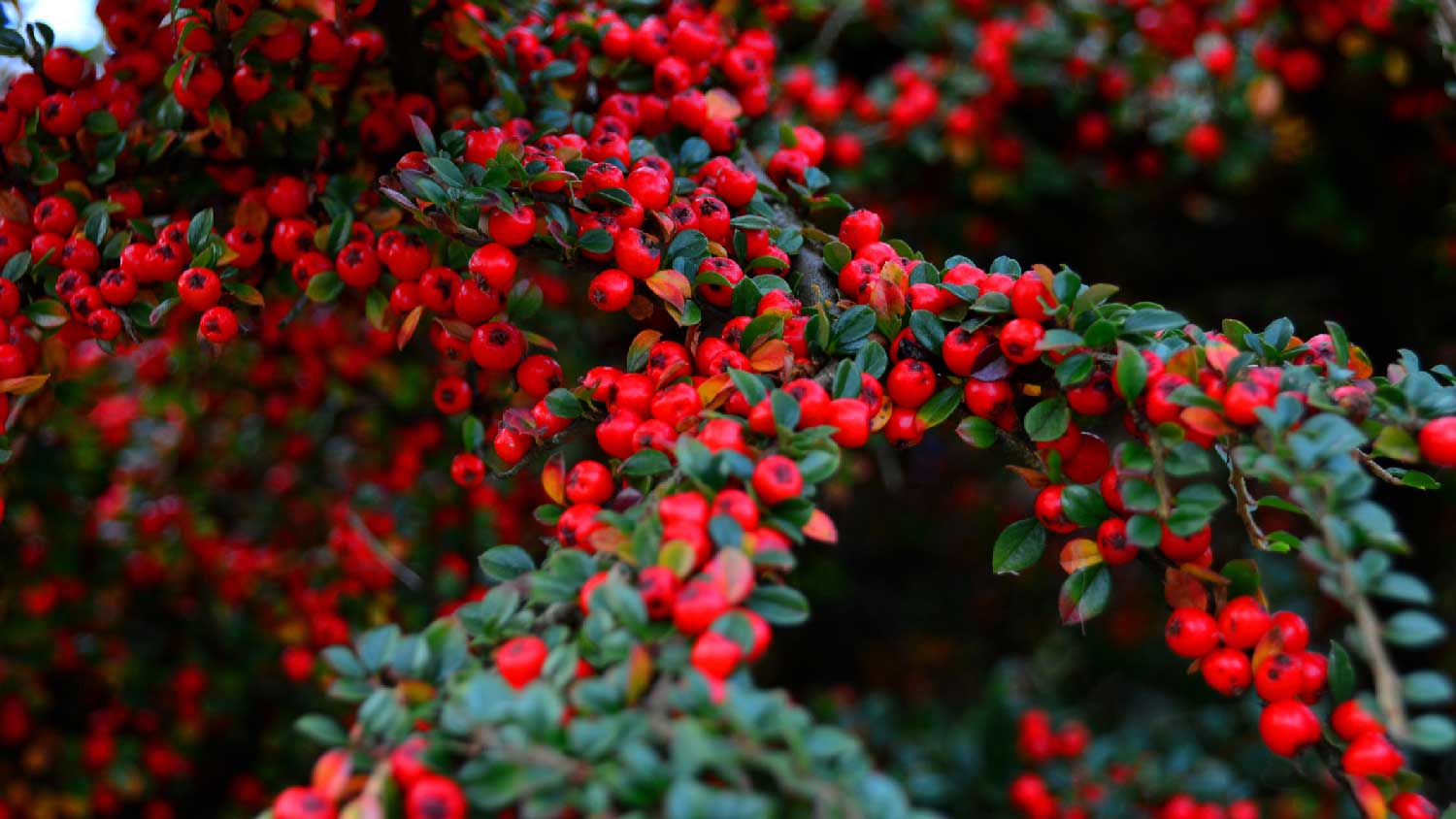
Sunlight Requirements: Full sun
Care: Regular pruning can help shape and control growth
USDA Hardiness Zones: 2–8
Cotoneasters, versatile in their use as ground cover or hedges, showcase small, glossy leaves and colorful berries. Their resilience and ornamental features make them an ideal choice for adding visual appeal and structure to gardens, whether cascading down slopes or forming robust hedges.
19. Gardenia
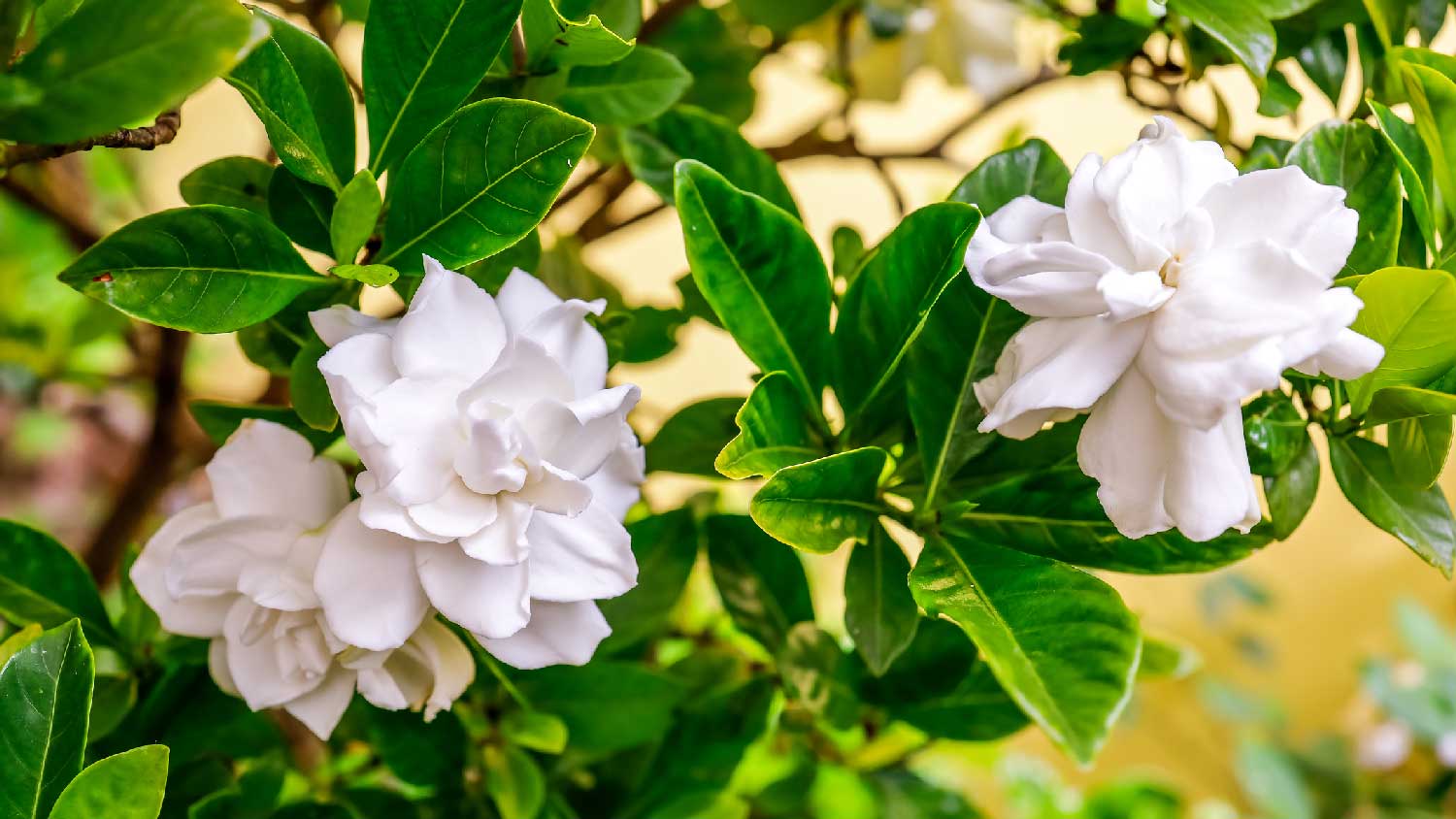
Sunlight Requirements: Partial shade
Care: Water regularly and fertilize as needed
USDA Hardiness Zones: 7–11
Gardenias are fragrant evergreen shrubs with bright white blossoms. Prized for their intoxicating scent, these shrubs bring an elegant and immersive sensory experience to a landscape.
20. Magnolia
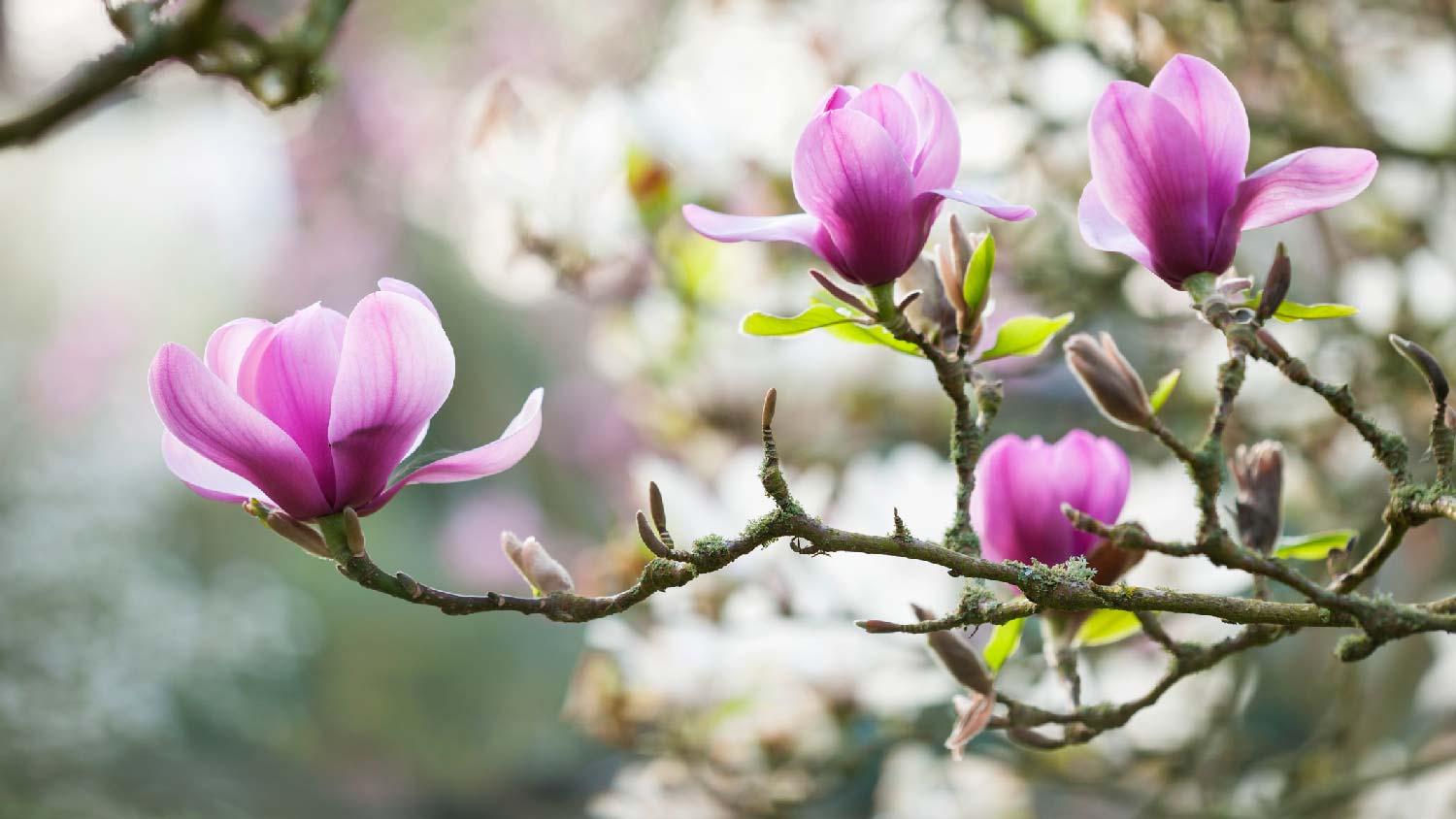
Sunlight Requirements: Full sun to partial shade
Care: Occasional pruning to shape and remove dead or damaged branches
USDA Hardiness Zones: 4–9
Magnolias, revered for their large, showy blossoms and captivating fragrance, are iconic flowering shrubs in landscapes. Their fragrant blooms and glossy foliage add grandeur and timeless sophistication to a landscape.
21. Butterfly Bush
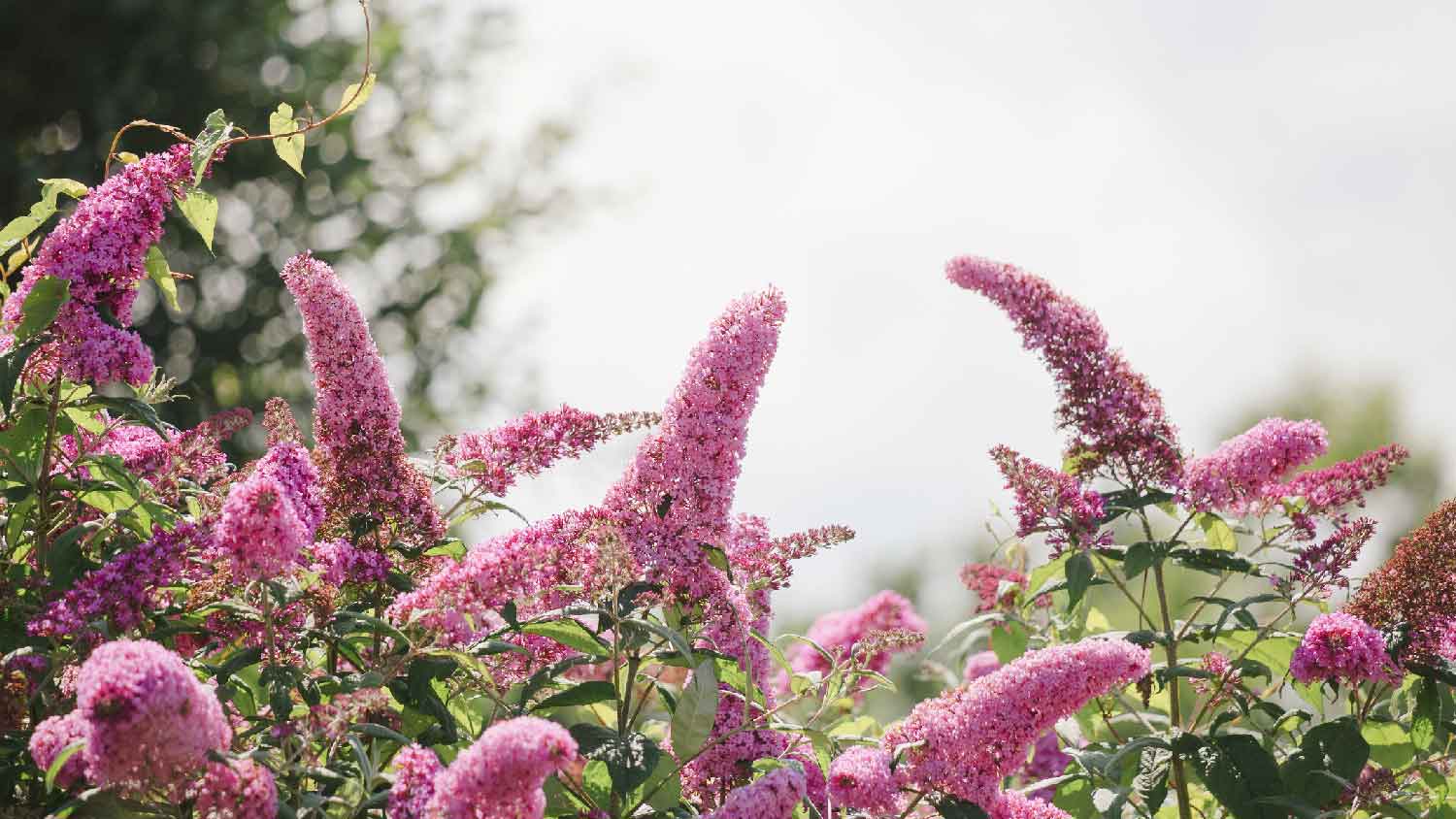
Sunlight Requirements: Full sun
Care: Prune in late winter to early spring to promote new growth
USDA Hardiness Zones: 5–9
Butterfly bushes are fast-growing shrubs with cone-shaped clusters of flowers. This popular plant is loved for its stunning, fragrant blooms and ability to lure butterflies. However, like burning bushes, butterfly bushes are considered invasive and are banned in some areas (like Washington state). For an alternative that makes an ideal plant for pollinator gardens, consider the similarly-named butterfly weed, a type of milkweed with bright orange flower clusters that’s native to many parts of North America.
22. Rose of Sharon

Sunlight Requirements: Full sun
Care: Occasional deep watering to help establish deep, flourishing roots
USDA Hardiness Zones: 5–9
Rose of Sharon is a deciduous bush that blooms with hibiscus flowers. This easy-to-care-for shrub brings prolonged floral displays and creates a long-lived colorful spectacle, making them a popular choice for landscapes.
23. Banana Shrub
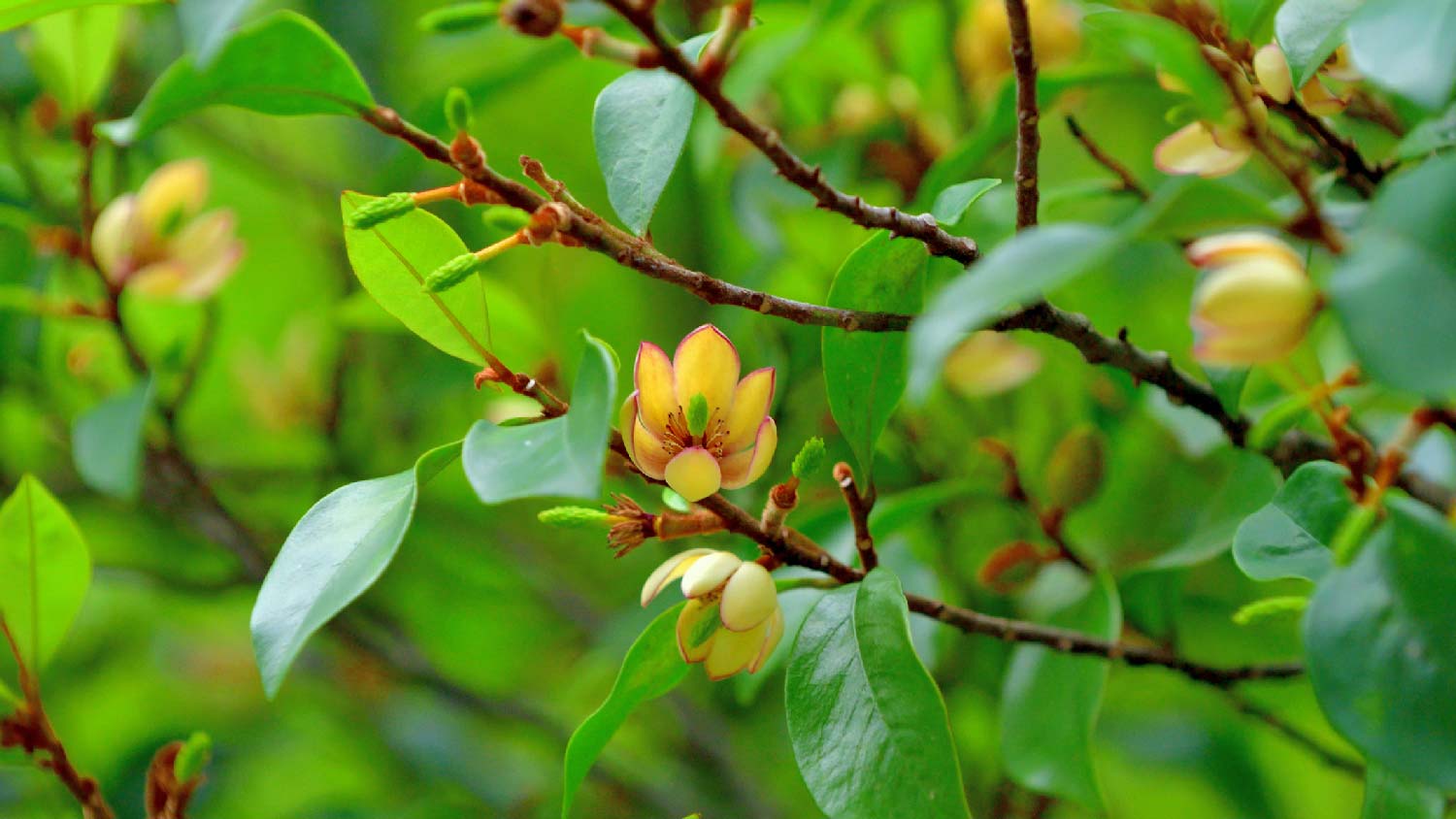
Sunlight Requirements: Partial shade
Care: Water regularly. Prune as needed to maintain shape
USDA Hardiness Zones: 7–10
Banana shrubs, evergreen and aromatic, bring a tropical touch to gardens and landscapes. True to the name, their creamy yellow flowers give off a distinct banana fragrance.
24. Honeysuckle
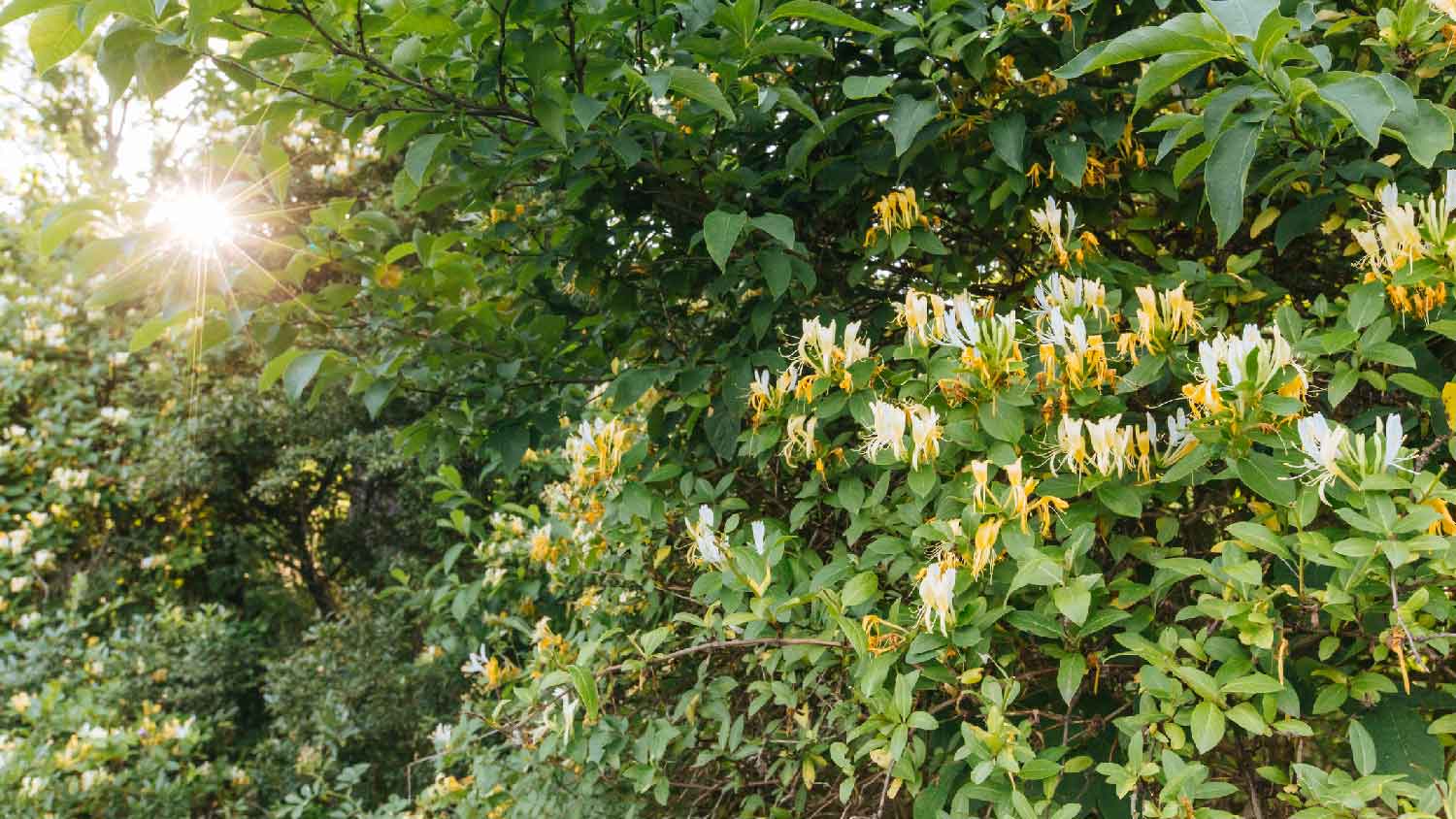
Sunlight Requirements: Full sun to partial shade
Care: Occasional pruning to control size and promote new growth
USDA Hardiness Zones: 5–9
Honeysuckles are available as climbing vines or arching bushes, and their tubular flower clusters come in a range of colors. Some kinds of honeysuckle are considered invasive, but there are many types of honeysuckle that are native to North America. Yellow honeysuckle, for example, has a strong, sweet floral aroma, while trumpet honeysuckle has coral-colored flowers that attract hummingbirds.
25. Poinsettia
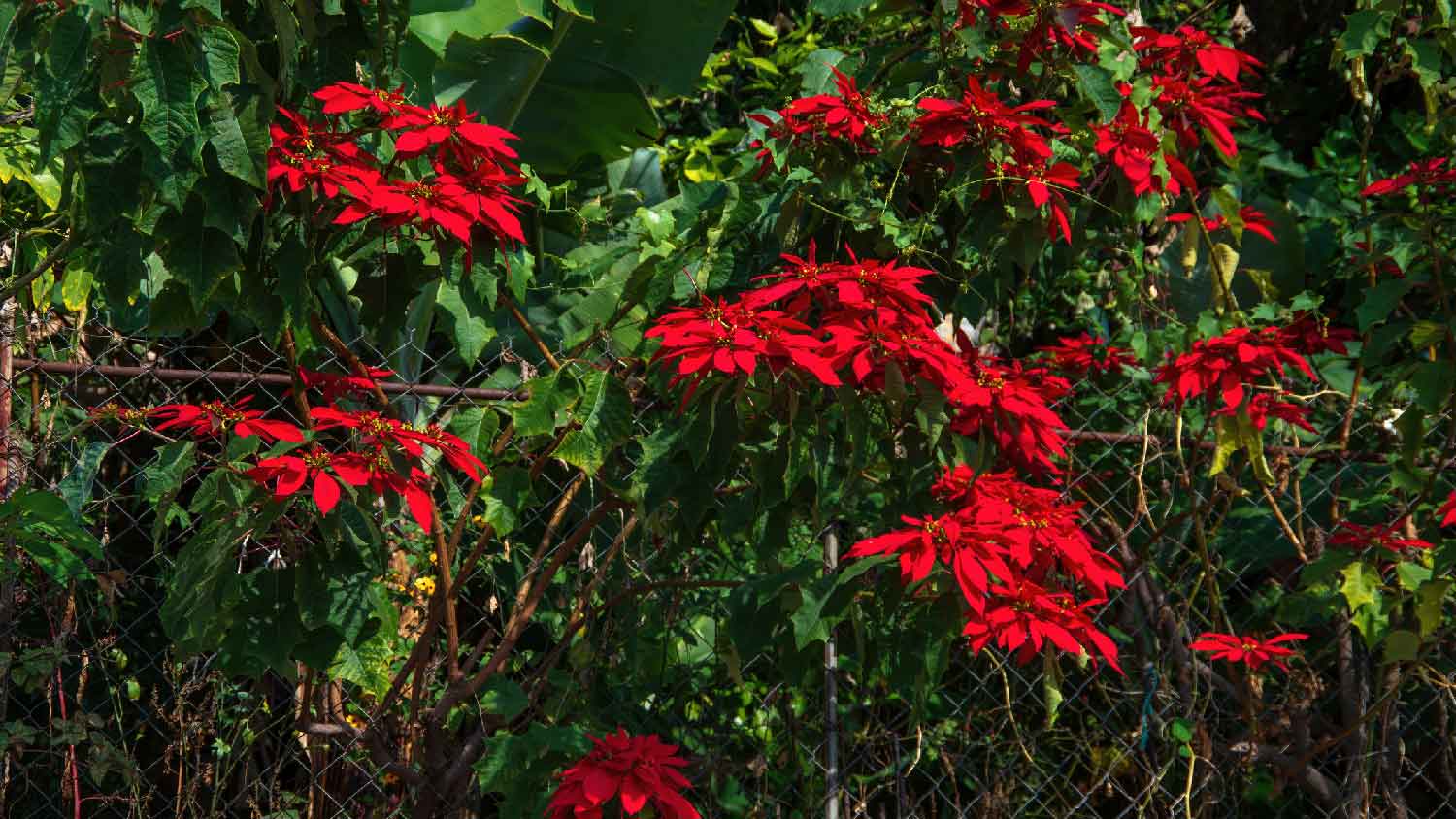
Sunlight Requirements: Partial shade
Care: Water consistently; avoid waterlogged conditions, cold drafts, and sudden temperature changes
USDA Hardiness Zones: 9–11
Poinsettias, renowned for their vibrant red, white, or pink foliage, are seasonal shrubs often associated with the holiday season's festive spirit. While their brilliant blooms are popular for holiday displays, they are toxic, so they must be kept away from pets.
Frequently Asked Questions
The terms “bush” and “shrub” are often used interchangeably, and in some instances, taller shrubs are referred to as “trees.” A shrub grows low to the ground and has several woody stems. However, it can grow as high as 15-feet tall. Bushes can also have several stems, but they are not woody. Shrubs only have one one set of roots that can’t be divided.
Unlike shrubs, trees have a single woody stem, from which branches grow to create a crown. Shrub branches also create a crown but without a stem and come up from ground-level.
The easiest shrubs to maintain depend on your area’s climate and soil type. Boxwood has topped many expert lists as a tough shrub. There are several varieties to choose from, so make sure the type you select is suitable for your area. Japanese spiraea is also an easily-grown deciduous flowering shrub, which you can trim, shape or leave alone.
The main characteristics of shrubs are they do not have a trunk, and their branches are low to the ground. They are broad-leafed, hardy plants that grow in all soil types. Mosty thrive in sunshine and are, therefore, seasonal. They can grow to be a few feet tall but are generally shorter than trees.





- Landscapers
- Tree Surgeons
- Gardening Services
- Landscape Architects
- Sod Installation
- Tennis Court Contractors
- Landscape Design
- Retaining Wall Companies
- Grading Companies
- Landscape Rock & Sand Delivery
- Mulch Delivery Services
- Pond Companies
- Artificial Grass Companies
- Shrub Removal & Trimming
- Backyard Design Companies
- Commercial Landscaping
- Koi Pond Services
- Backyard Landscapers
- Trampoline Assembly
- Hedge Trimming
- Pond Services
- Garden Design
- Outdoor Plant Watering
- Putting Greens
- French Drains
- Turf Installation
- Sod Removal Services
- Lawn Repair Services
- Brush Chipping Services
- Hardscape Contractor
- Landscape Rock Removal
- 10 Outdoor Plants You (Most Likely) Can’t Kill
- Add Some Street Style: 10 Trees With Great Curb Appeal
- 10 Great Trees for Bees and Other Pollinators
- 26 Plants That Are Perfect for Shaded Gardens
- Here’s When to Trim Your Bushes and Shrubs
- 32 Drought-Tolerant Trees and Shrubs to Have in Your Yard
- When to Prune Shrubs
- The Top 20 New Plants Hitting the Market in 2024
- 13 Best Vines to Grow on Pergolas and Enhance Your Outdoor Space
- 53 Summer Flowers: Your Guide to a Vibrant Garden










